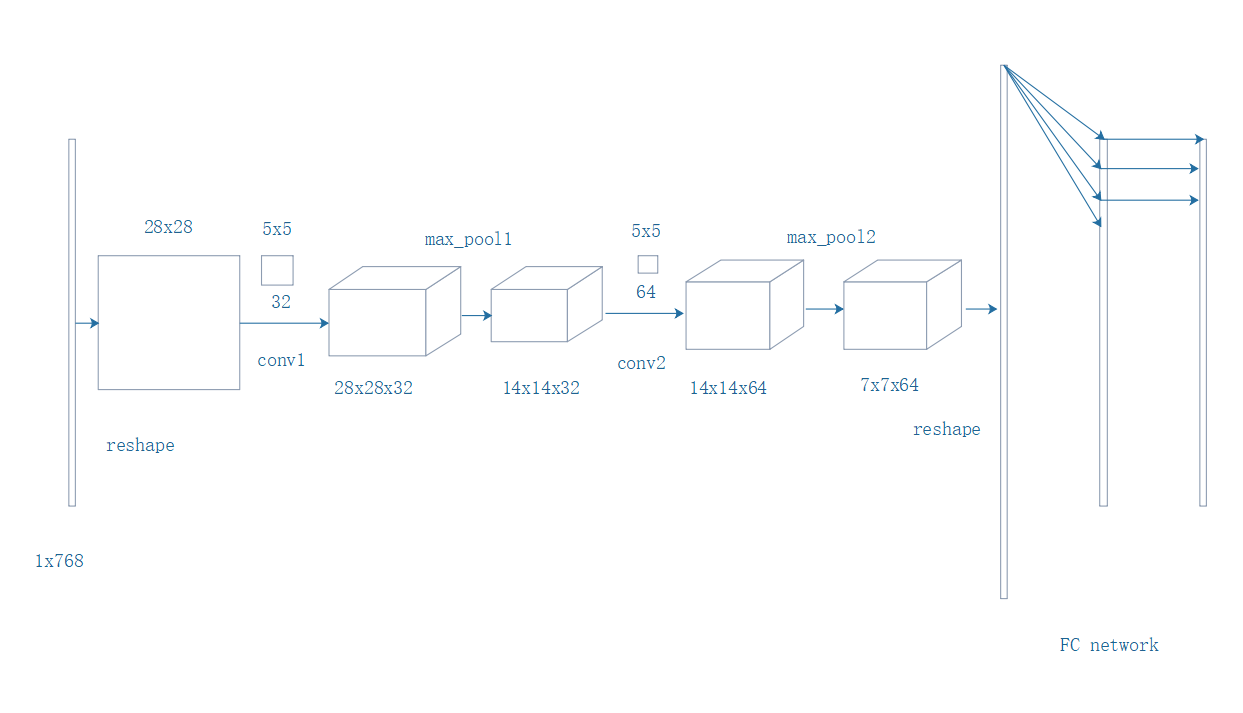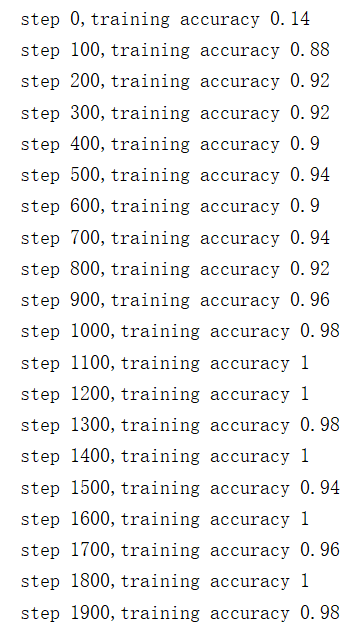上次的程序识别率只能达到91%左右,所以没什么乱用,今天使用CNN模型进行改进,识别率能达到98%。
上码!
1 import tensorflow as tf 2 import tensorflow.examples.tutorials.mnist.input_data as input_data 3 mnist = input_data.read_data_sets('/temp/', one_hot=True) 4 5 6 #定义两个函数用于初始化 7 #避免0梯度 8 def weight_variable(shape): 9 initial = tf.truncated_normal(shape,stddev=0.1) 10 return tf.Variable(initial) 11 12 def bias_variable(shape): 13 initial = tf.constant(0.1,shape=shape) 14 return tf.Variable(initial) 15 16 #卷积和池化 17 def conv2d(x,W): 18 return tf.nn.conv2d(x,W,strides=[1,1,1,1],padding='SAME') 19 20 def max_pool_2x2(x): 21 return tf.nn.max_pool(x,ksize=[1,2,2,1],strides=[1,2,2,1],padding='SAME') 22 23 #输入和输出 24 x = tf.placeholder(tf.float32,[None,784]) 25 y_ = tf.placeholder(tf.float32,[None,10]) 26 27 #tensorflow 对话 28 sess = tf.Session() 29 30 #设置第一层卷积 31 W_conv1 = weight_variable([5,5,1,32]) 32 b_conv1 = bias_variable([32]) 33 34 x_image = tf.reshape(x,[-1,28,28,1]) 35 36 h_conv1 = tf.nn.relu(conv2d(x_image,W_conv1)+b_conv1) 37 h_pool1 = max_pool_2x2(h_conv1) 38 39 #第二层卷积 40 W_conv2 = weight_variable([5,5,32,64]) 41 b_conv2 = bias_variable([64]) 42 43 h_conv2 = tf.nn.relu(conv2d(h_pool1,W_conv2)+b_conv2) 44 h_pool2 = max_pool_2x2(h_conv2) 45 46 #密集连接层 全连接层 47 W_fc1 = weight_variable([7*7*64,1024]) 48 b_fc1 = bias_variable([1024]) 49 50 h_pool2_flat = tf.reshape(h_pool2,[-1,7*7*64]) 51 h_fc1 = tf.nn.relu(tf.matmul(h_pool2_flat,W_fc1)+b_fc1) 52 53 #减少过拟合 加入dropout 54 keep_prob = tf.placeholder("float") 55 h_fc1_drop = tf.nn.dropout(h_fc1,keep_prob) 56 57 #输出层 58 W_fc2 = weight_variable([1024,10]) 59 b_fc2 = bias_variable([10]) 60 61 y_conv = tf.nn.softmax(tf.matmul(h_fc1_drop,W_fc2)+b_fc2) 62 63 #交叉熵 64 cross_entropy = -tf.reduce_sum(y_*tf.log(y_conv)) 65 train_step = tf.train.AdamOptimizer(1e-4).minimize(cross_entropy) 66 67 #评估模型 68 correct_prediction = tf.equal(tf.argmax(y_conv,1),tf.argmax(y_,1)) 69 accuracy = tf.reduce_mean(tf.cast(correct_prediction,"float")) 70 sess.run(tf.initialize_all_variables()) 71 72 for i in range(2000): 73 batch = mnist.train.next_batch(50) 74 if i % 100 ==0: 75 train_accuracy = accuracy.eval(session=sess,feed_dict={x:batch[0],y_:batch[1],keep_prob:1.0}) 76 print("step %d,training accuracy %g" %(i,train_accuracy)) 77 train_step.run(session=sess,feed_dict={x:batch[0],y_:batch[1],keep_prob : 0.5}) 78 79 print ("test accuracy %g"%accuracy.eval(session=sess,feed_dict={x: mnist.test.images, y_: mnist.test.labels, keep_prob: 1.0}))
--------------------------------------------------------------华丽的分割线------------------------------------------------------------------------------
79行,比上次复杂了一点而已i,下面有一张图可以更好的帮助理解CNN网络。
首先是1~3行,这个就不解释了,不懂可以参考上一篇文章。
6 #定义两个函数用于初始化 7 #避免0梯度 8 def weight_variable(shape): 9 initial = tf.truncated_normal(shape,stddev=0.1) 10 return tf.Variable(initial) 11 12 def bias_variable(shape): 13 initial = tf.constant(0.1,shape=shape) 14 return tf.Variable(initial)
6~14行是用于增加网络的层数,每增加一层就可以条用这两个函数来设置权重变量和偏置变量。
这里用到的tensorflow函数有:
tf.truncated_normal(shape, mean, stddev) 产生正太分布的函数,参数分别是张量维度、均值、方差
tf.constant tensorflow的常量类型
tf.Variable tensorflow的变量类型
--------------------------------------------------------------华丽的分割线------------------------------------------------------------------------------
16 #卷积和池化 17 def conv2d(x,W): 18 return tf.nn.conv2d(x,W,strides=[1,1,1,1],padding='SAME') 19 20 def max_pool_2x2(x): 21 return tf.nn.max_pool(x,ksize=[1,2,2,1],strides=[1,2,2,1],padding='SAME')
16~21行是定义卷积和池化,这里用到的tensorflow函数有:
tf.nn.conv2d(input, filter, strides, padding) 实现二维的卷积
tf.nn.max_pool(value, ksize, strides, padding) 实现最大值池化操作
W是卷积核,步长为1
池化是[[1,2][2,1]]的矩阵,步长为2
--------------------------------------------------------------华丽的分割线------------------------------------------------------------------------------
23 #输入和输出
24 x = tf.placeholder(tf.float32,[None,784])
25 y_ = tf.placeholder(tf.float32,[None,10])
26
27 #tensorflow 对话
28 sess = tf.Session()
23~28行就是我们的输入和真值的占位符设置,此外还有tensorflow的Session对话。
--------------------------------------------------------------华丽的分割线------------------------------------------------------------------------------
前面定义了几个重要的函数,现在就开始构建我们的计算图了,先看图:

30 #设置第一层卷积
31 W_conv1 = weight_variable([5,5,1,32])
32 b_conv1 = bias_variable([32])
33
34 x_image = tf.reshape(x,[-1,28,28,1])
35
36 h_conv1 = tf.nn.relu(conv2d(x_image,W_conv1)+b_conv1)
37 h_pool1 = max_pool_2x2(h_conv1)
34行就是先把表示图片的1x768向量转化成矩阵形式,即转化为28x28形状,参数1表示单通道;
然后定31、32行设置我们的卷积核,大小是5x5的卷积核,输入通道数为1,输出通道数为32,偏置的个数也32个;
接着就是隐藏层的输出,这里使用的是RELU激活函数,也就是tensorflow的
tf.nn.relu 函数 ,参数就是我们的卷积函数加上偏置就得到隐藏层的输出;
最后是池化层的输出,这里用的卷积形式都是padding = ‘SAME' 形式,也就是输出形状宽(高)=输入形状宽(高)/步长
如图所示,得到我们的28x28x32和14x14x32的32卷积层和池化层
39 #第二层卷积 40 W_conv2 = weight_variable([5,5,32,64]) 41 b_conv2 = bias_variable([64]) 42 43 h_conv2 = tf.nn.relu(conv2d(h_pool1,W_conv2)+b_conv2) 44 h_pool2 = max_pool_2x2(h_conv2)
根据图所示,构建第二层卷积层和池化层,这里不赘述了,参考第一层。
46 #密集连接层 全连接层 47 W_fc1 = weight_variable([7*7*64,1024]) 48 b_fc1 = bias_variable([1024]) 49 50 h_pool2_flat = tf.reshape(h_pool2,[-1,7*7*64]) 51 h_fc1 = tf.nn.relu(tf.matmul(h_pool2_flat,W_fc1)+b_fc1)
前面通过两层卷积和池化之后,需要重新转换为向量形式,作为全连接层的输入 也就是50行代码所示,
还有权重和偏置的设置如47、48行,这个和上一篇文章是一样的,理解了上一篇文章,然后根据图示,自然很容易理解了
最后的激活函数仍是使用RELU函数,到此计算图构建完毕。
--------------------------------------------------------------华丽的分割线------------------------------------------------------------------------------
53 #减少过拟合 加入dropout
54 keep_prob = tf.placeholder("float")
55 h_fc1_drop = tf.nn.dropout(h_fc1,keep_prob)
56
57 #输出层
58 W_fc2 = weight_variable([1024,10])
59 b_fc2 = bias_variable([10])
60
61 y_conv = tf.nn.softmax(tf.matmul(h_fc1_drop,W_fc2)+b_fc2)
62
63 #交叉熵
64 cross_entropy = -tf.reduce_sum(y_*tf.log(y_conv))
65 train_step = tf.train.AdamOptimizer(1e-4).minimize(cross_entropy)
58~65行基本上是上一篇文章的内容,这里主要是53~55行,通过tensorflow的dropout来减少过拟合
原理大致是通过选择概率,随机使某些隐层神经元不工作,处于无法激活状态,在进行训练的多次迭代过程中
相当于产生多种不同的网络,最后输出的结果相当于这些网络的平均效果,以此达到减少过拟合。
与上一篇文章一样的,使用交叉熵作为损失函数,同时这里用新的优化算法Adam。
--------------------------------------------------------------华丽的分割线------------------------------------------------------------------------------
67 #评估模型
68 correct_prediction = tf.equal(tf.argmax(y_conv,1),tf.argmax(y_,1))
69 accuracy = tf.reduce_mean(tf.cast(correct_prediction,"float"))
70 sess.run(tf.initialize_all_variables())
71
72 for i in range(2000):
73 batch = mnist.train.next_batch(50)
74 if i % 100 ==0:
75 train_accuracy = accuracy.eval(session=sess,feed_dict={x:batch[0],y_:batch[1],keep_prob:1.0})
76 print("step %d,training accuracy %g" %(i,train_accuracy))
77 train_step.run(session=sess,feed_dict={x:batch[0],y_:batch[1],keep_prob : 0.5})
78
79 print ("test accuracy %g"%accuracy.eval(session=sess,feed_dict={x: mnist.test.images, y_: mnist.test.labels, keep_prob: 1.0}))
最后就是我们的评估模型了,别忘记了70行的我们需要对所有变量进行初始化。
然后就是训练我们的模型,每100次迭代输出一次测试结果,每次训练小批量数据50个,注意到keep_prob参数
该参数就是dropout所确定的概率,1.0就是全部神经元工作,0.5就是随机选择一半神经元不工作,以此达到减少过拟合。
代码就79行,下面来看看运行的结果:

从精确率看来,平均水平能达到98%,从而改进了上一篇文章中的简单模型,
把准确率大幅提高,这样的网络才有较好的用途。
(但是还有更多其他的模型,仍然继续深入大坑!)